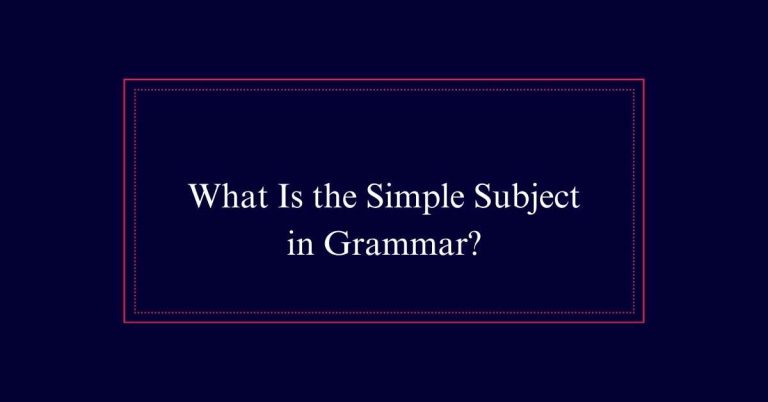What Are Verbs With “S”? Definition and Examples
Verbs ending in ‘s’ are regular verbs in the third-person singular form, used when the subject is he, she, or it. For instance, ‘he runs,’ ‘she watches,’ and ‘it buzzes.’ Adding ‘s’ or ‘es’ guarantees subject-verb agreement, an essential part of English grammar. This agreement makes sentences clear and grammatically correct. Understanding these forms helps convey actions related to singular subjects, maintain proper grammar, and improve writing and speech clarity. Examples include ‘walks,’ ‘fixes,’ and ‘teaches.’
Verbs Ending in ‘S’
In the third-person singular simple-present tense, regular verbs typically end in ‘s’. For instance, ‘Ahmet cooks so well’ and ‘He knows precisely what ingredients and tools to use.’ These examples illustrate how the verbs ‘cooks’ and ‘knows’ end in ‘s’ to agree with the third-person singular subject.
However, exceptions exist for verbs ending in s, x, z, ch, or sh. These verbs do not add an additional ‘s’. Instead, they use ‘es’ to form the third-person singular. Examples include ‘watches’ and ‘fixes’.
Understanding this rule is crucial for proper subject-verb agreement in English. Consistent application of these endings ensures clear and grammatically correct sentences, enhancing both writing and speech.
Verb Conjugation Basics
Understanding verb conjugation is essential for mastering English grammar. Verb conjugation involves changing the form of a verb to show tense, mood, voice, number, and person. This process helps convey when an action occurs and who is performing it.
For instance, verbs can be in the past, present, or future tense. They can also be singular or plural. In the present tense, regular verbs change form to match the subject.
For example, ‘run’ becomes ‘runs’ when the subject is third-person singular like ‘he,’ ‘she,’ or ‘it.’ Proper conjugation guarantees that sentences are clear and grammatically correct. Knowing these basics is key to effective communication in English.
Third-Person Singular Tense
Mastering verb conjugation leads us to the third-person singular tense. This tense is vital for expressing actions related to he, she, or it.
In English, regular verbs in this form typically end with ‘s’. For example, ‘He plays soccer’ or ‘She reads books.’ However, verbs ending in s, x, z, ch, or sh do not add an additional ‘s’, but rather ‘es’ instead. For instance, ‘He watches TV’ or ‘She fixes the car.’

Understanding these rules is essential for proper grammar. The third-person singular tense is used in the simple present to describe habitual actions, general truths, and current facts. This helps in making sentences clear and grammatically correct.
Singular Subjects
Singular subjects require verbs to agree in person and number, ensuring grammatical consistency. When a verb is used with a singular subject in the third-person, it typically ends in ‘s’. This rule applies to many regular verbs. For example, the verb “run” becomes “runs” when the subject is “he,” “she,” or “it”. However, the verb does not change when the subject is “I” or “you” in singular form.
| Singular Subject | Verb |
|---|---|
| He | runs |
| She | writes |
| It | jumps |
| The cat | sleeps |
These examples show how verbs change to maintain agreement with singular subjects, helping sentences remain clear and grammatically correct.
Subject-Verb Agreement
In English grammar, subject-verb agreement guarantees that verbs match their subjects in person and number. This rule guarantees clarity and correctness in sentences.
For example, in the sentence, ‘She removes her shoes before going into her apartment,’ the verb ‘removes’ agrees with the third-person singular subject ‘she.’
Similarly, ‘Canada observes Boxing Day as a public holiday every December 26’ shows proper agreement with the singular subject ‘Canada’ and the verb ‘observes.’
Subject-verb agreement is essential for clear communication. Plural subjects take verbs without ‘s,’ as in ‘They enjoy their daily run.’ Singular subjects take verbs with ‘s,’ as in ‘He enjoys his daily run.’
Proper agreement enhances both written and spoken English.
Frequently Asked Questions
What Are Some Common Irregular Verbs in English?
Common irregular verbs in English include “go,” “be,” “have,” “do,” “say,” “make,” “take,” “come,” “see,” and “get.” These verbs do not follow standard conjugation rules and have unique forms in different tenses.
How Do Auxiliary Verbs Function in a Sentence?
Auxiliary verbs, also known as helping verbs, assist the main verb to form tenses, voices, and moods. They include forms of “be,” “have,” and “do.” For example, “She is running,” and “He has finished.”
What Is the Difference Between Transitive and Intransitive Verbs?
Transitive verbs require a direct object to complete their meaning, indicating who or what receives the action. Intransitive verbs do not need a direct object and convey a complete thought on their own.
How Do Modal Verbs Affect Verb Conjugation?
Modal verbs like “can,” “will,” and “must” do not conjugate for number or person. They are followed by the base form of the main verb. For example, “She can swim” and “They will go.”
Can You Provide Examples of Phrasal Verbs?
Phrasal verbs are combinations of verbs and prepositions or adverbs. Examples include “give up,” “look after,” and “break down.” These combinations create meanings different from the original verb. Phrasal verbs are common in English.






